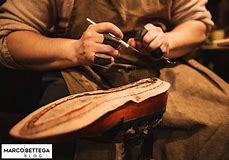 |
| A young shoemaker in the 50s |
It was the 1950s
and I still remember the smell of leather that my father used to build or
repair shoes.
At that time, the shoes were tailor-made and entirely by hand, there were still
no machines. Shoemaking was considered a profession, but also an art. To make a
pair of shoes, the shoemaker first drew the model of the shoe he had in mind on
a sheet of paper, of what he found, which could have been a sheet of newspaper
or straw paper. Subsequently, the paper model was glued onto a light cardboard
that allowed the shoemaker to cut the upper and linings well, which would then
wrap around the shape.
In those days the shapes were made of wood and the shoemaker, from time to
time,  modelled them according to the anatomical shape of the client's foot. To
make the shoe well reinforced, the welt (leather band of about 4 centimetres)
was applied between the upper and the sole, shaped around the edges of the shape. The welt (in sicilian language 'u
vaddiuni), in order to be shaped, needed first to be let soaking in the water
in a terracotta container (in sicilian language ‘u
scifu) for about 5/6 days. Normally it took a week of hard work to complete a
pair of shoes.
modelled them according to the anatomical shape of the client's foot. To
make the shoe well reinforced, the welt (leather band of about 4 centimetres)
was applied between the upper and the sole, shaped around the edges of the shape. The welt (in sicilian language 'u
vaddiuni), in order to be shaped, needed first to be let soaking in the water
in a terracotta container (in sicilian language ‘u
scifu) for about 5/6 days. Normally it took a week of hard work to complete a
pair of shoes.
 |
| Shoemaking with modern machinery |
Now everything has changed, shoes are built in factories through
"assembly lines"; there are no longer the old cobblers, but there are still rich knowledge and traditions that we should transmit to young people, so
that they will last in time.
By Salvatore Cifalinò








